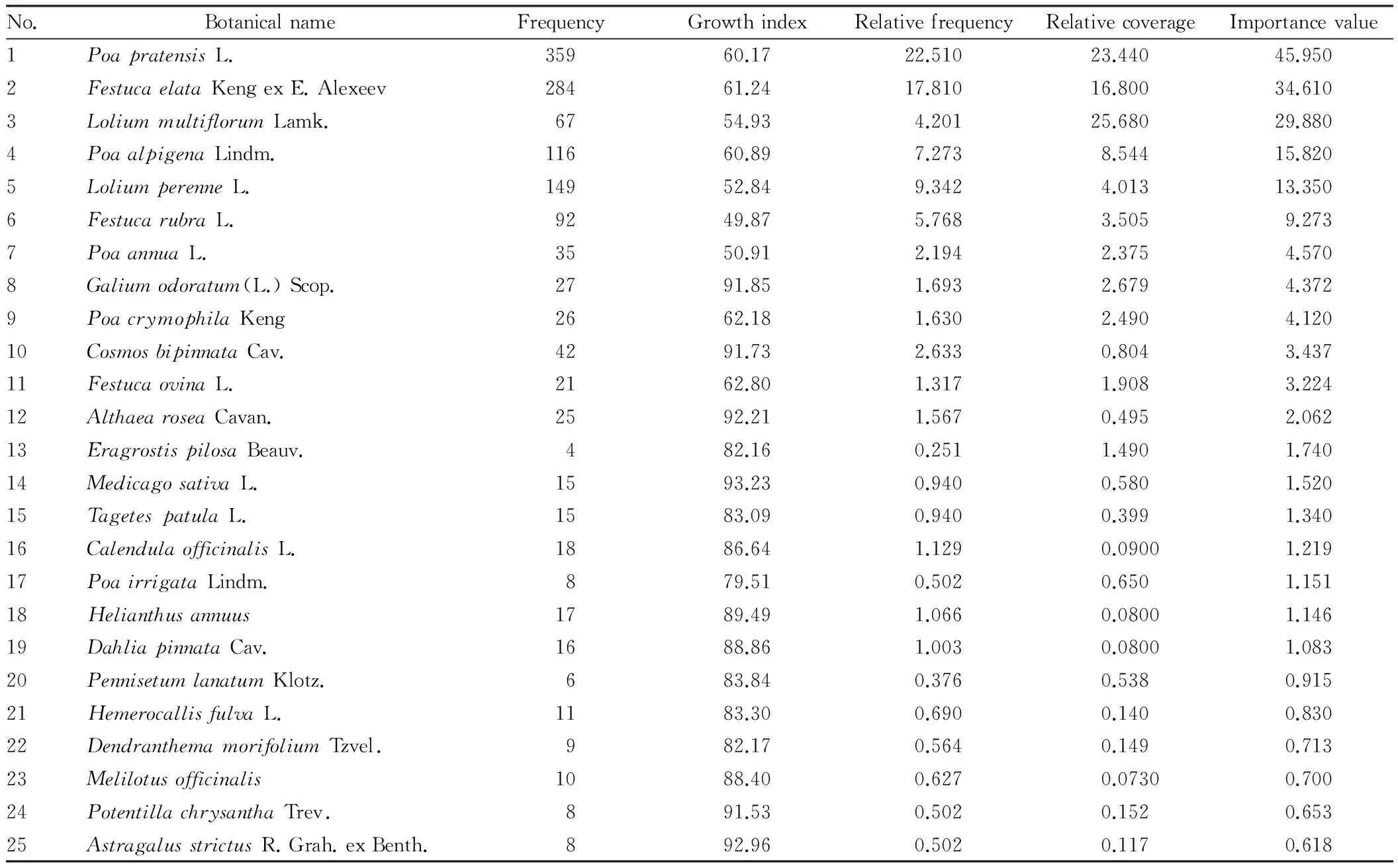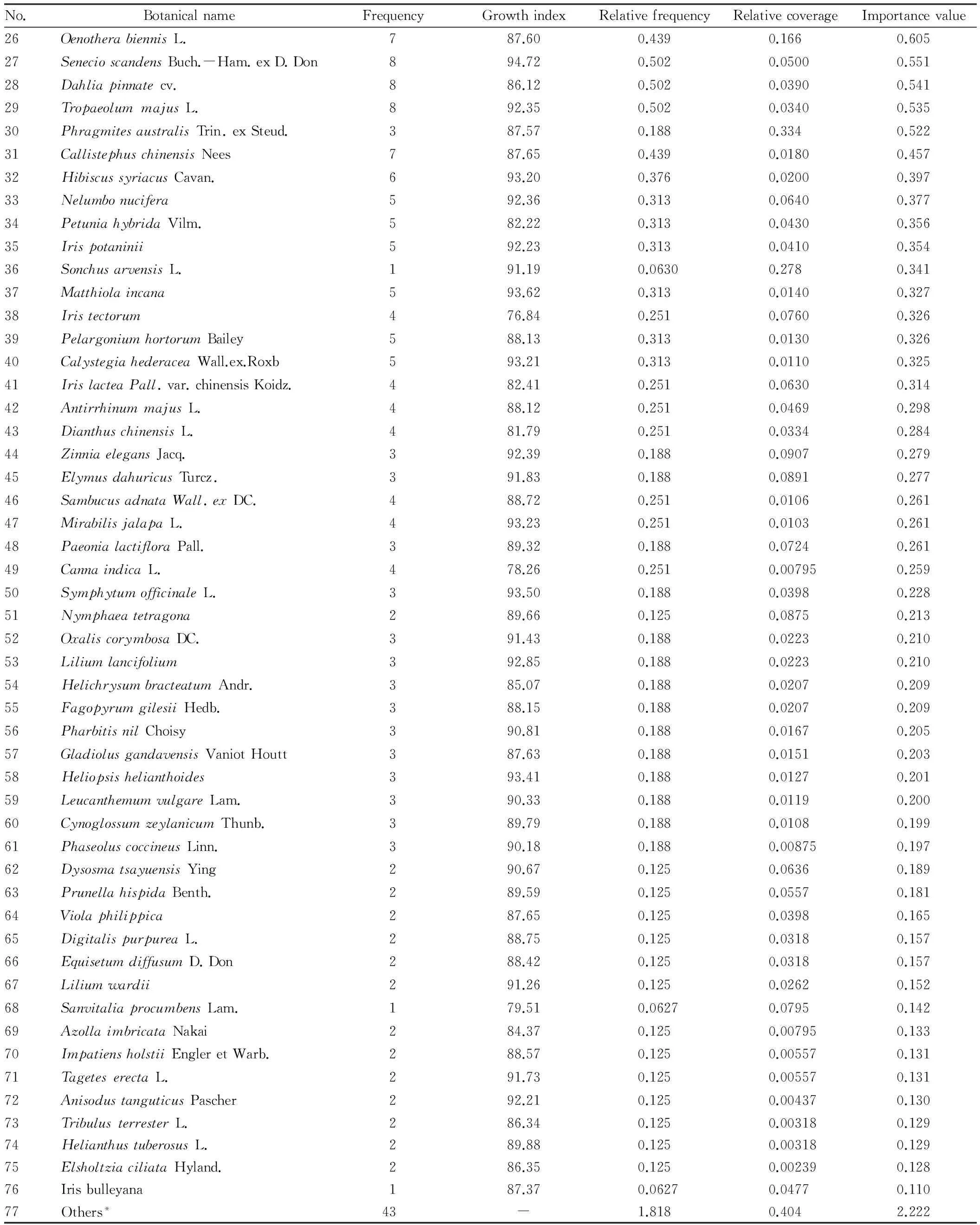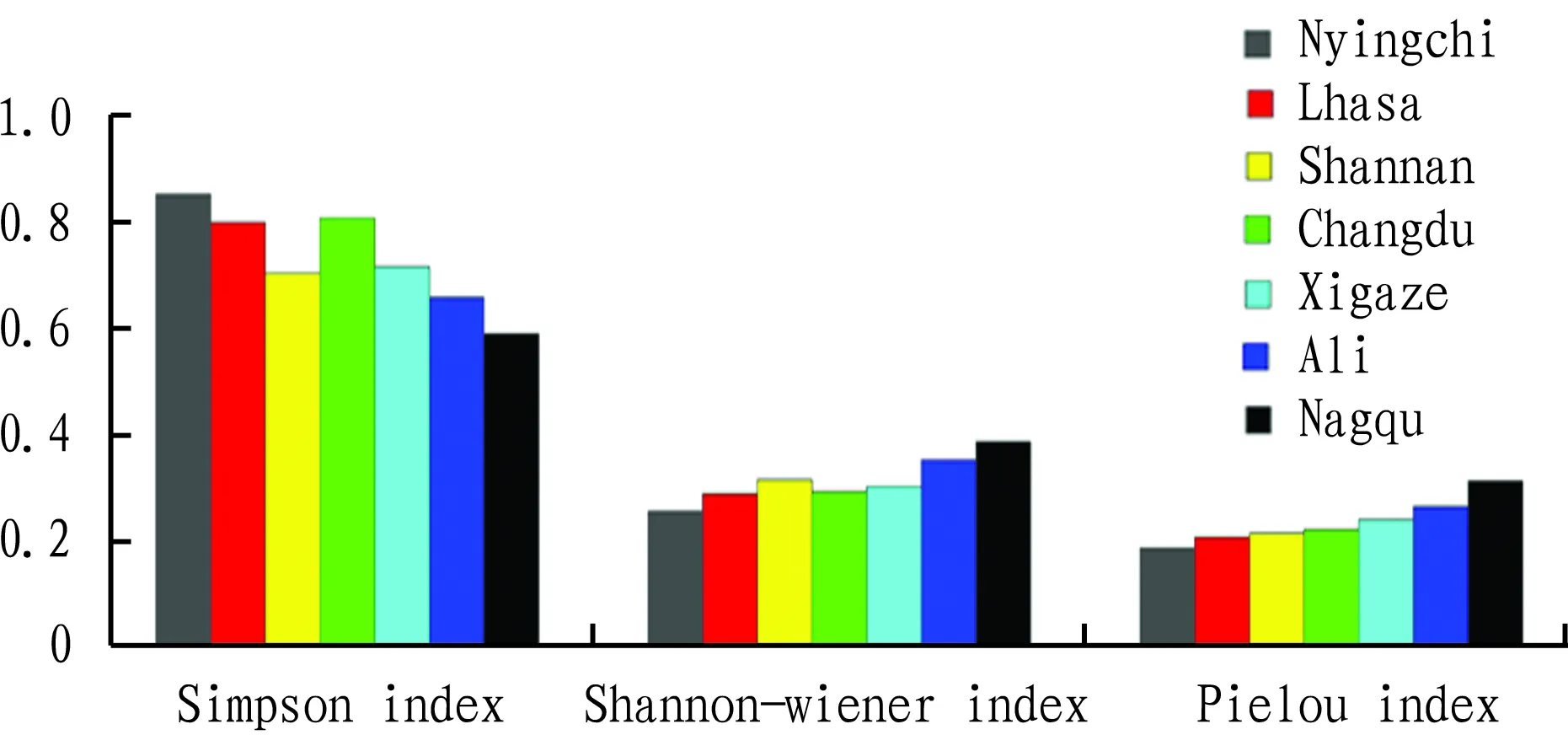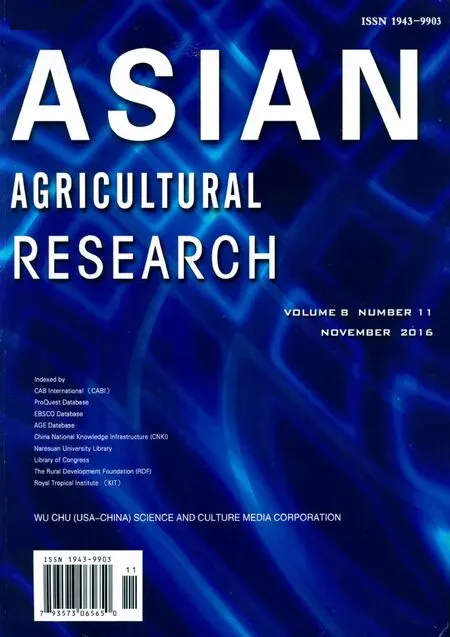Study on the Ground Cover Plant in Tibetan Herb Garden
2016-01-12,,,,,
, , , , ,
Department of Resources and Environment, Tibet Agricultural and Animal Husbandry College, Linzhi 860000, China
1 Introduction
The ground cover plants in herb garden are the current or perennial plants with underdeveloped xylem of stems, few lignified cells, weak and short herbaceous stem. In a broad sense, they include lawn plants; in a narrow sense, they include the above defined plants except lawn plants[1]. In this paper, the ground cover plants in a broad sense are regarded as the object of study. The ground cover herbaceous plants do not need regular pruning, and have the features of resisting pest and disease and extensive management, in line with the requirements of conservation-oriented landscape, having become one of the development trends of green city[2]. To clearly know the basic situation of ground cover plants in Tibetan herb garden and solve the problems in greening, we use "importance value", Shannon-wiener, Pielou index for quantitative analysis, and make a comprehensive survey of species and application of ground cover plants in Tibetan herb garden for the first time, with a view to providing guidance for landscaping in the region.
2 Study area
Tibet is a region on the Tibetan Plateau in Asia, with an area of 1220000 km2. Tibet is the highest region on Earth, with an average elevation of 4900 m. The highest elevation in Tibet is Mount Everest, Earth’s highest mountain, rising 8848 m above sea level. Terrain tilts from northwest to southeast, and the terrain is complex and diverse. It is roughly divided into four areas: the north Tibet plateau, the south Tibet valley, east Tibet mountains and valleys, and Himalaya Mountains. It is bitterly cold in winter, with a marked difference in temperature between daytime and night. It features scarce precipitation and a sharp contrast between the dry and wet seasons. It is dry in winter and spring, with frequent occurrence of strong winds, as well as low oxygen content. The climate types from southeast to northwest are tropical zone, subtropical zone, plateau temperate zone, plateau subfrigid zone and plateau frigid zone[3].
3 Survey and methods
3.1SurveymethodsThe site survey was conducted on Tibetan 7 cities from June 2014 to September 2015. In the survey area, it is divided into the patch types of park, production, protection, accessory, roads and green space, and the sample plots are set up according to different plant communities. According to the survey point size, using "five-point sampling method", several 1 m × 1 m standard plots are randomly set up respectively in the herbaceous layer for community and diversity investigation[4]. The plot accounts for 0.2‰ of the surveyed urban green space, and the minimum number of plots is not less than 20[5-6]. The information about the name, growth stages, coverage, arrangement model and wild nature of each plant is amply recorded, and the arrangement status of plants is photographed. The canopy density is calculated by eye-measurement[7].
3.2MethodsThe survey uses the analysis methods for plant community quantitative characteristics to calculate importance value, Simpon index, Shannon-wiener index, Pielou index, growth index, and species abundance index, respectively[8]. The importance value of three types of plants is calculated as follows:
Importancevalue=Relativefrequency+Relativeprojectedcoverage.
The related index is calculated as follows:
SpeciesabundanceindexN0=S
Shannon-wienerindexH=-∑Nln(Ni/N)
PielouindexJsw=D/lns
whereNiis the number of speciesi;Nis the total number of species;Sis the number of species type.
As for the evaluation method for growth index, various vegetative organs of each plant are evaluated according to a certain indicator system, and then the total scores are weighted to determine the health level. It is divided into 5 levels, and the grading standard is shown in Table 1[9-10].
Growthindex=(∑Numberofplantsateachlevel×series)/(Totalnumberofplants×Highestlevelseries)×100.
Table1Classificationstandardofgrowthindex

LevelIndicators0Witheredleavesandleaves,thewholeplantonthebrinkofdeath,lossofornamentalvalue1Weakgrowth,seriouspestsanddiseases,brokenbranchesandleaves,repugnanttotheeye2Goodgrowth,commonconditions,occasionalpestsanddiseasesorbrokenbranchesandleaves,withacertainornamentalvalue3Goodplantformandgrowthconditions,asmallnumberofpestsanddiseases,withhighornamentalvalue4Beautifulplantform,stronggrowth,nopestsanddiseases,withextremelyhighornamentalvalue
4 Survey results and analysis
4.1QuantitativecharacteristicsofspeciesTable 2 shows that there are a total of 119 kinds of herbaceous layer plants. Survey results show that in Tibetan seven cities, the lawn grass is mainly in herbaceous layer, the importance value ofPoapratensisL. is highest, and there is serious convergence for the lawn class ground cover plants with importance value in the top five; in the non-lawn class ground cover plants,TrifoliumL. has the highest importance value. In terms of growth, the artificial turf growth index is generally poor and below 65, while the rural ground cover plant growth index is generally high. In general, for the ground cover plants in Tibetan herb garden, except the lawn grass, the non-lawn ground cover plants are mostly underdeveloped, and they are mainly wild flowers. In terms of relative frequency,TrifoliumL.>MedicagosativaL.>HibiscussyriacusCavan.>Melilotusofficinalis>PotentillachrysanthaTrev.>AstragalusstrictusR. Grah. ex Benth.>SenecioscandensBuch.-Ham. ex D. Don. In terms of relative frequency, the main artificial flora ground cover plants are in the order ofCosmosbipinnataCav.>Althaearosea(Linn.) Cavan.>TagetespatulaL.>CalendulaofficinalisL. They are common in the artificial flower beds, and can not form the landscape effect of multifarious ground cover plant species with high ornamental value.
Table2ThecharacteristicsstatisticsofgroundcoverplantspeciesinTibetanherbgarden

No.BotanicalnameFrequencyGrowthindexRelativefrequencyRelativecoverageImportancevalue1PoapratensisL.35960.1722.51023.44045.9502FestucaelataKengexE.Alexeev28461.2417.81016.80034.6103LoliummultiflorumLamk.6754.934.20125.68029.8804PoaalpigenaLindm.11660.897.2738.54415.8205LoliumperenneL.14952.849.3424.01313.3506FestucarubraL.9249.875.7683.5059.2737PoaannuaL.3550.912.1942.3754.5708Galiumodoratum(L.)Scop.2791.851.6932.6794.3729PoacrymophilaKeng2662.181.6302.4904.12010CosmosbipinnataCav.4291.732.6330.8043.43711FestucaovinaL.2162.801.3171.9083.22412AlthaearoseaCavan.2592.211.5670.4952.06213EragrostispilosaBeauv.482.160.2511.4901.74014MedicagosativaL.1593.230.9400.5801.52015TagetespatulaL.1583.090.9400.3991.34016CalendulaofficinalisL.1886.641.1290.09001.21917PoairrigataLindm.879.510.5020.6501.15118Helianthusannuus1789.491.0660.08001.14619DahliapinnataCav.1688.861.0030.08001.08320PennisetumlanatumKlotz.683.840.3760.5380.91521HemerocallisfulvaL.1183.300.6900.1400.83022DendranthemamorifoliumTzvel.982.170.5640.1490.71323Melilotusofficinalis1088.400.6270.07300.70024PotentillachrysanthaTrev.891.530.5020.1520.65325AstragalusstrictusR.Grah.exBenth.892.960.5020.1170.618
(to be continued)
(continued)

No.BotanicalnameFrequencyGrowthindexRelativefrequencyRelativecoverageImportancevalue26OenotherabiennisL.787.600.4390.1660.60527SenecioscandensBuch.-Ham.exD.Don894.720.5020.05000.55128Dahliapinnatecv.886.120.5020.03900.54129TropaeolummajusL.892.350.5020.03400.53530PhragmitesaustralisTrin.exSteud.387.570.1880.3340.52231CallistephuschinensisNees787.650.4390.01800.45732HibiscussyriacusCavan.693.200.3760.02000.39733Nelumbonucifera592.360.3130.06400.37734PetuniahybridaVilm.582.220.3130.04300.35635Irispotaninii592.230.3130.04100.35436SonchusarvensisL.191.190.06300.2780.34137Matthiolaincana593.620.3130.01400.32738Iristectorum476.840.2510.07600.32639PelargoniumhortorumBailey588.130.3130.01300.32640CalystegiahederaceaWall.ex.Roxb593.210.3130.01100.32541IrislacteaPall.var.chinensisKoidz.482.410.2510.06300.31442AntirrhinummajusL.488.120.2510.04690.29843DianthuschinensisL.481.790.2510.03340.28444ZinniaelegansJacq.392.390.1880.09070.27945ElymusdahuricusTurcz.391.830.1880.08910.27746SambucusadnataWall.exDC.488.720.2510.01060.26147MirabilisjalapaL.493.230.2510.01030.26148PaeonialactifloraPall.389.320.1880.07240.26149CannaindicaL.478.260.2510.007950.25950SymphytumofficinaleL.393.500.1880.03980.22851Nymphaeatetragona289.660.1250.08750.21352OxaliscorymbosaDC.391.430.1880.02230.21053Liliumlancifolium392.850.1880.02230.21054HelichrysumbracteatumAndr.385.070.1880.02070.20955FagopyrumgilesiiHedb.388.150.1880.02070.20956PharbitisnilChoisy390.810.1880.01670.20557GladiolusgandavensisVaniotHoutt387.630.1880.01510.20358Heliopsishelianthoides393.410.1880.01270.20159LeucanthemumvulgareLam.390.330.1880.01190.20060CynoglossumzeylanicumThunb.389.790.1880.01080.19961PhaseoluscoccineusLinn.390.180.1880.008750.19762DysosmatsayuensisYing290.670.1250.06360.18963PrunellahispidaBenth.289.590.1250.05570.18164Violaphilippica287.650.1250.03980.16565DigitalispurpureaL.288.750.1250.03180.15766EquisetumdiffusumD.Don288.420.1250.03180.15767Liliumwardii291.260.1250.02620.15268SanvitaliaprocumbensLam.179.510.06270.07950.14269AzollaimbricataNakai284.370.1250.007950.13370ImpatiensholstiiEngleretWarb.288.570.1250.005570.13171TageteserectaL.291.730.1250.005570.13172AnisodustanguticusPascher292.210.1250.004370.13073TribulusterresterL.286.340.1250.003180.12974HelianthustuberosusL.289.880.1250.003180.12975ElsholtziaciliataHyland.286.350.1250.002390.12876Irisbulleyana187.370.06270.04770.11077Others*43-1.8180.4042.222
Note: * means that there are a total of 42 other kinds of plants, with importance value less than 0.100.
4.2PlantcompositionSurvey shows that there are a total of 46 families, 95 genera, 119 species of ground cover plants in Tibetan herb garden, and there are 8 species of herbaceous climbing plants, accounting for only 6.72% of the surveyed plants. The families used most includeAsteraceae(22),Gramineae(15),Leguminosae(8),Labiatae(7),Iridaceae(6) andLiliaceae(5), accounting for 18.49%, 12.61%, 6.72%, 5.88%, 5.04% and 4.20% of the surveyed plants, respectively. In terms of the plant composition, there are 64 kinds of native plants and 55 kinds of introduced plants, accounting for 53.78% and 46.22% of the surveyed plants, respectively. From the point of view of plant life cycle, there are 36 kinds of annual plants, 7 kinds of biennial plants and 76 kinds of perennial plants, accounting for 30.25%, 5.88% and 63.87% of the surveyed plants. It is dominated by the perennial herb garden ground cover plants.
4.3CharacteristicsofspeciesabundanceSurvey results show that the average species abundance of ground cover plants in Tibetan herb garden in each plot is 2.9, and the highest species abundance is 18. From Table 3, it can be found that Tibetan garden plant diversity is not wide and greening level is not high, with great differences. It is highest in Nyingchi and lowest in Nagqu. The greening pattern is relatively complex in the key towns of Nyingchi, Lhasa and Shannan; the greening structure is very simple in other places.
Table3SpeciesabundancestatisticsaboutthegroundcoverplantsinTibetanherbgarden

No.RegionsSpeciesabundanceindexTheaveragenumberofspeciesintheplot1Nyingchi1014.562Lhasa483.393Shannan272.914Changdu262.935Xigaze202.686Ali131.957Nagqu121.88
4.4SpeciesdiversityindexBy comparing the diversity index, it is found that in terms of Simpon index, the difference is significant, it is highest in Nyingchi and lowest in Nagqu; in terms of Shannon-wiener index and Pielou index, the difference is not significant. It indicates that there are significant differences in the diversity of Tibetan herb garden ground cover plant community, and the convergence is weak for all regions; there are no significant differences in homogeneity and dominance, and the convergence is strong for all regions.PoapratensisL.,Festucaarundinace,TrifoliumL. andCosmosbipinnataCav. are heavily used as ground cover plants in Tibetan herb garden, so the difference in various values is small. It also shows that the greening landscape uniqueness is not obvious for the ground cover plants in Tibetan herb garden.

Fig.1Speciesdiversityindexcomparison
4.5GreeningmodeAs for the green plants in Tibet, the upper layer trees mainly consist of white willow, cedar,PopulusbeijingensisW. Y. Hsu and elm, and white willow and cedar are dominant species. The middle layer plants consist ofPrunusceraiferacv.Pissardii,Sabinachinensis(L.)Ant.cv.Kaizuca,RosachinensisJacq.,BuxusmegistophyllaLevl.,Ligustrum×vicaryiHort,Photiniaxfraseri,Berberisthunbergiivar.atropurpureaChenault,Platycladusorientalis’sieboldii’, andcv.AureaNana. The lower layer plants are mainly composed of turf grass and a small number of ground cover plants such asTrifoliumL.,CosmosbipinnataCav.,Althaearosea(Linn.) Cavan.,CalendulaofficinalisL.,MedicagosativaL.,DohliaPinnata,Dendranthemamorifolium(Ramat.)Tzvel.,Matthiolaincana,Tropaeolummajus., andTaraxacumsherriffii[11]. The survey finds that in the wild, the gardens highly popular throughout Tibet often spontaneously form a large area of natural flower border, creating spectacular, stunning visual effects[13]. Various regions of Tibet place insufficient emphasis on non-lawn ground cover plants, and the large-scale ground cover plant landscape is mostly natural lawn landscape decorated with flowers rather than artificially created landscape[12]. It is mainly based onTaraxacumsherriffii,Potentillachrysantha,Sophoramoorcroftiana, andEquisetumdiffusumD. Don.
4.6LawnmaintenancelevelDue to Tibetan unique and harsh plateau natural environment, there are serious natural disasters in the landscaping area, with dry and windy winters. Due to the special natural environment conditions and constraints of concepts, funds and other factors, the maintenance level is low in Tibetan garden. Survey results show that the green space rate of non-artificial lawn in Tibet reaches as high as 38.51%, especially for Ali, Nagqu and Xigaze. The lawn with sparse grass is very common, and most of the artificial lawns are at maintenance level-4, dependent on the weather conditions (Table 4).
Table4ThelawnmaintenancelevelinTibet

Maintenancelevel1234Maintenancerate∥%0.000.5620.9378.51
5 Conclusions and discussions
5.1ConclusionsThis paper conducts a comprehensive survey of the ground cover plant in Tibetan herb garden for the first time using "five-point sampling method". Survey results show that: (i) A total of 46 families, 95 genera, 119 species of ground cover plants in herb garden are applied in Tibet, andAsteraceae,Gramineae,Leguminosae,Labiatae,IridaceaeandLiliaceaeare used most, with the species number of 22, 15, 8, 7, 6 and 5, respectively, accounting for 18.49%, 12.61%, 6.72%, 5.88%, 5.04% and 4.20% of the plants surveyed, respectively. (ii) In terms of importance value for the herbaceous layer, the top three plants arePoapratensisL.,FestucaarundinaceandLoliummultiflorumL., with the importance value of 45.950, 34.610 and 29.880, respectively; in terms of importance value for the non-turf ground cover herb plants, the top three plants areTrifoliumL., CosmosbipinnataCav. andAlthaearosea(Linn.) Cavan., with the importance value of 4.372, 3.437 and 2.062, respectively. (iii) The overall level of greening is low and uneven in the region, with large regional differences. In terms of ground cover plant abundance, Nyingchi>Lhasa>Shannan>Changdu>Xigaze>Ali>Nagqu.
5.2DiscussionsThe survey shows that the landscaping diversity is poor and the problem of single configuration is prominent for Tibetan herb ground cover plants. The key factor affecting plant growth in the region is water factor, and it is mainly the water lack before germinating period in winter and spring[14]. For the regions with serious shortage of water, we can consider increasing the extensively managed plants with strong adaptability, such asTrifoliumL.,Taraxacumsherriffii, andPotentillachrysantha. For the artificial lawn sensitive to water, it is necessary to place particular emphasis on watering in maintenance. In terms of species abundance index (Table 3), Tibetan green species abundance varies widely, and the greening development is highly uneven; it is highest in Nyingchi but generally poor in other cities. In Bayi District of Nyingchi City, Chengguan District of Lhasa City and Zedang Town of Shannan City, the artificial herbaceous ground cover plants are relatively abundant after several years of transformation and development[11, 15]. Contrastingly, it is mainly based on wild ground cover plants in other places, and the artificial ground cover plants are sporadically used, with monotonous level and poor species abundance. In Nagqu, it is mainly dominated by the model of "natural lawn decorated with rare shrubs", and most of green space has no tree layer and the single configuration problem is very prominent[11, 16]. Tibetan terrain difference leads to great changes in regional precipitation, largely affecting the ground cover plant abundance in the herb garden[17]. Survey results show that a total of 119 kinds of herb garden ground cover plants are used in Tibet, most in Nyingchi (101) and least in Nagqu (12), and there are significant regional differences in herb garden ground cover plant application (Table 7). In terms of plant resources and development, Tibet has rich native plant gardens, and Motuo County has more than 3500 kinds of plant resources[18]. Many outstanding native garden plants have not been fully utilized, including many excellent native ground cover plants in herb garden. In the future, it is necessary to focus on the selective breeding, and promote the local characteristic lawns decorated with flowers and the natural flower border plants with low maintenance cost, such as mallow,Taraxacumsherriffii,Potentillachrysantha,IrislacteaandCalystegiahederaceaWall. There is also a need to strengthen the study on application form and innovation of rural lawn decorated with flowers and flower border.
[1] HU LZ, GUAN XJ, MENG KA,etal. Introduction, screening and application evaluation of herbaceous ground cover plant in Hunan[J]. Journal of Southern Agriculture, 2013, 44(12): 2053-2057. (in Chinese).
[2] MA J, HAN LB, JIANG T. Assessment of ecological benefit for the introduction of drought-resistance and wild herbaceous ground cover species in Beijing area[J]. Journal of Beijing Forestry University, 2006, 28(1):51-55. (in Chinese).
[3] Comprehensive Scientific Expedition of Qinghai-Tibet Plateau, Chinese Academy of Sciences. Tibet forest[M]. Beijing: Science Press, 1985. (in Chinese).
[4] DONG SP. Study on the composition feature of gardening plant communities in main urban areas of Chongqing City[D]. Chongqing: SouthwestUniversity, 2006:16-18. (in Chinese).
[5] ZHAO JJ, OUYANG ZY, ZHENG H,etal. Proposed procedure in designing and planning stratified random selection investigation of urban vegetation[J]. Chinese Journal of Ecology,2009,28(7):1430-1436. (in Chinese).
[6] LI DS, GUO WJ, JI ZQ,etal. The impact of sample area and sample amount on the results of community species diversity measure-A case study with the shrub community in the west region of Yanshan Mountain[J]. Acta Agriculturae Universitis Jiangxiensis,2008,30(6):1079-1084. (in Chinese).
[7] LI K, WANG J, SHI L,etal. Research on the status of southern canal waterfront greening and plant landscape in Shenyang [J]. Journal of Shenyang Jianzhu University:Social Science, 2013,15(2):153-155. (in Chinese).
[8] DU LH. Studies on the investigation and application of green plants in Nanjing new rural[D]. Nanjing:Nanjing Forestry University, 2012(6): 45-50. (in Chinese).
[9] LI YQ. Plant landscape research in Lijiang temple landscape architecture[D]. Ya’an:Sichuan Agricultural University,2009: 16-18. (in Chinese).
[10] TANG L. Study on the characteristics of garden plant community of the main temple garden in Chengdu[D]. Ya’an:Sichuan Agricultural University,2009: 20-21. (in Chinese).
[11] LIU ZN, XU J, ZHANG HF,etal. Investigation and application of landscape plants in Tibet[J]. Acta Agriculturae Zhejiangensis, 2016,28(6):1009-1017. (in Chinese).
[12] LIU ZN, PAN G, ZHANG HF,etal. Investigation and application of landscape plants in Linzhi City of Tibet[J]. Acta Agriculturae Zhejiangensis, 2016,28(2):273-283. (in Chinese).
[13] LIU ZN, PAN G, ZHANG HF,etal. Greening patterns of Tibetan courtyards in Linzhi City[J]. Landscape Research, 2016, 8(2):16-20.
[14] LIU ZN, PAN G, ZHANG HF,etal. Investigation and application research of landscape plants in Tibet of Shigatse City[J].Northern Horticulture, 2015(20):74-78. (in Chinese).
[15] LIU ZN, PAN G, ZHANG HF,etal. Investigation and application research on landscape plants in Lhasa[J]. Journal of Yunnan Agricultural University, 2016,31(4):670-680. (in Chinese).
[16] LIU ZN, PAN G, ZHANG HF,etal. Research on landscape plants in Shannan of Tibet[J]. Journal of Shandong Agricultural University(Natural Science Edition), 2016,47(7):82-89. (in Chinese).
[17] DA PQ, ZHANG KL, YE YH,etal. Restricting factors and countermeasures of reforestation project in Tibet Lhasa[J].Tibetan Science & Technology,2010(5):13-16. (in Chinese).
[18] XING Z. A quantitative research onthe benefit of ecological environment of landscape plant in Tibet[M]. Beijing:Social Sciences Academic Press(China), 2014. (in Chinese).
杂志排行
Asian Agricultural Research的其它文章
- Innovation on Distant Hybridization of Saline-tolerant Mud Flat Spartina and Rice Germplasm
- Advances in Studies of Genetic Improvement of Sugarcane
- Necessities and Practical Approaches for Beautiful Countryside Construction
- A Study of the Issues concerning Development of China’s Agricultural Product Logistics
- Review of Agricultural Insurance Development in the New Period in China
- Development of Neural Network for BLSOM Clustering of HA Genes of Avian Influenza Viruses Isolated in Guangdong Province
